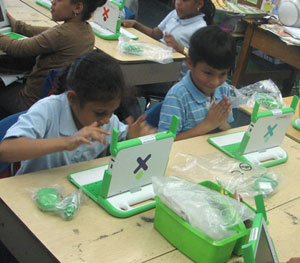As part of our efforts to support low-cost computing and expand on our positive experiences using the XOs in NYC classrooms, Teaching Matters has partnered with Birmingham City Schools and Tala Professional Services to train teachers and technology coordinators in Birmingham. By the end of this month, every child in grades one through five in Birmingham City Schools will have an XO laptop. This is an incredible opportunity for the 14,000 students who have not had reliable access to technology in school.
In late 2007, Mayor Larry Langford of Birmingham, Alabama purchased the XO laptops, with the goal of closing the digital divide and ensuring that the children of the city have access to the tools they need to succeed in the digital age. This is the first large-scale purchase of XOs in the United States. In the spring of 2008, the XOs were piloted at Glen Iris Elementary School. The pilot had positive results, and plans were developed to deploy the laptops to the other children in the city. Birmingham was on its way to providing every child with access to technology.
This past fall, Teaching Matters consultants trained 35 technology coordinators on how to operate the XO along with how to support and maintain them at the school level. Then, we spent a total of three weeks traveling around the city training over 500 teachers on how to use the XOs and integrate them into their classrooms. The Birmingham teachers recognized the incredible potential these computers brought to their classroom, and they were eager to find ways to use the XOs with their students.
Whether it involved taking pictures to illustrate student writing or using the chat activity to facilitate book club discussions, the teachers saw the opportunities to use the XOs as a tool in their classroom to engage students and teach them skills they need to succeed in the 21st century.


